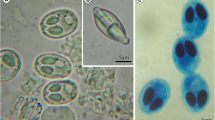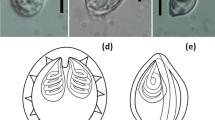Abstract
Myxozoans are economically important cnidarian endoparasites. Members of this group have been traditionally characterized by a morphology-based taxonomic system. Because myxozoans possess few morphological characters, these data are routinely accompanied by biological traits (host/organ/tissue specificity) and molecular data when describing or identifying myxozoan species. In the present study, a species of Myxobolus was collected from the fins of yellow catfish Tachysurus fulvidraco Richardson, 1846, which was consistent in spore morphology and host/organ specificity with Chinese records of Myxobolus physophilus Reuss, 1906. However, these earlier records and our own findings are inconsistent with the original description of M. physophilus from Russia. Specifically, there are differences in spore morphology (shape, intercapsular appendix, and polar capsule size), the infection site (air bladder vs. fins), and the host affinity (common rudd vs. yellow catfish). The inconsistencies allow us to conclude that both the present Myxobolus species and Chinese records of M. physophilus are distinct from the original description of M. physophilus and represent a new Myxobolus species, which we named Myxobolus xiantaoensis n. sp.





Similar content being viewed by others
References
Abdel-Ghaffar F, Abdel-Baki AA, Garhy ME (2005) Ultrastructural characteristics of the sporogenesis of genus Myxobolus infecting some Nile fishes in Egypt. Parasitol Res 95:167–171. https://doi.org/10.1007/s00436-004-1250-1
Atkinson SD, Bartošová-Sojková P, Whipps CM, Bartholomew JL (2015) Approaches for characterising Myxozoan species. In: Myxozoan evolution, ecology and development. Springer International Publishing Cham, Basel, pp 111–123. https://doi.org/10.1007/978-3-319-14753-6_6
Chen C (1973) Classification of pathogens. Illustration of fish pathogens in Hubei Province. Science Press, Beijing
Chen QL, Ma CL (1998) Fauna Sinica: Myxozoa, Myxosporea. Science Press, Beijing
Eiras J, Molnár K, Lu Y (2005) Synopsis of the species of Myxobolus Bütschli, 1882 (Myxozoa: Myxosporea: Myxobolidae). Syst Parasitol 61:1–46. https://doi.org/10.1007/s11230-004-6343-9
Eiras JC, Zhang J, Molnár K (2014) Synopsis of the species of Myxobolus Bütschli, 1882 (Myxozoa: Myxosporea, Myxobolidae) described between 2005 and 2013. Syst Parasitol 88:11–36. https://doi.org/10.1007/s11230-014-9484-5
Eszterbauer E (2004) Genetic relationship among gill-infecting Myxobolus species (Myxosporea) of cyprinids: molecular evidence of importance of tissue-specificity. Dis Aquat Org 58:35–40. https://doi.org/10.3354/dao058035
Ferguson JA, Atkinson SD, Whipps CM, Kent ML (2008) Molecular and morphological analysis of Myxobolus spp. of salmonid fishes with the description of a new Myxobolus species. J Parasitol 94:1322–1334. https://doi.org/10.1645/GE-1606.1
Fiala I (2006) The phylogeny of Myxosporea (Myxozoa) based on small subunit ribosomal RNA gene analysis. Int J Parasitol 36:1521–1534. https://doi.org/10.1016/j.ijpara.2006.06.016
Fiala I, Bartošová-Sojková P, Whipps CM (2015) Classification and phylogenetics of Myxozoa. In: Myxozoan evolution, ecology and development. Springer nternational Publishing Cham, Basel, pp 85–110. https://doi.org/10.1007/978-3-319-14753-6_5
Forró B, Eszterbauer E (2016) Correlation between host specificity and genetic diversity for the muscle-dwelling fish parasite Myxobolus pseudodispar: examples of myxozoan host–shift? Folia Parasitol 63(019). https://doi.org/10.14411/fp.2016.019
Guindon S, Dufayard J–F, Lefort V, Anisimova M, Hordijk W, Gascuel O (2010) New algorithms and methods to estimate maximum–likelihood phylogenies: assessing the performance of PhyML 3.0. Syst Biol 59:307–321. https://doi.org/10.1093/sysbio/syq010
Hall TA (1999) BioEdit: a user-friendly biological sequence alignment editor and analysis program for windows 95/98/NT. Nucleic Acids Symp Ser 41:95–98
Heiniger H, Adlard RA (2013) Molecular identification of cryptic species of Ceratomyxa Thélohan, 1892 (Myxosporea: Bivalvulida) including the description of eight novel species from apogonid fishes (Perciformes: Apogonidae) from Australian waters. Acta Parasitol 58:342–360
Hillis DM, Dixon MT (1991) Ribosomal DNA: molecular evolution and phylogenetic inference. Inference Q Rev Biol 66:411–453
Holzer AS, Sommerville C, Wootten R (2004) Molecular relationships and phylogeny in a community of myxosporeans and actinosporeans based on their 18S rDNA sequences. Int J Parasitol 34:1099–1111. https://doi.org/10.1016/j.ijpara.2004.06.002
Katoh K, Standley DM (2013) MAFFT multiple sequence alignment software version 7: improvements in performance and usability. Mol Biol Evol 30:772–780. https://doi.org/10.1093/molbev/mst010
Kudo R (1919) Illinois biological monographs. In: Forbes SA, Trelease W, Ward HB (eds). Published quarterly under the auspices of the graduate school by the University of Illinois, Urbana, Illinois, p 155
Kudo R (1933) A taxonomic consideration of Myxosporidia. Trans Am Microsc Soc 52:195–216
Liu S (1997) A study on the biology of Pseudobagrus fulvidraco in poyanglake. Chin J Zool 32:10–16
Liu Y (2014) Revision on genus Myxobolus (Myxozoa: Myxosporea) and taxonomy of some Myxobolus species in China. Ph.D. dissertation submitted in Huazhong Agricultural University, Wuhan, P.R. China
Liu Y, Whipps CM, Nie P, Gu Z (2014) Myxobolus oralis n. sp. (Myxosporea: Bivalvulida) infecting the palate in the mouth of gibel carp Carassius auratus gibelio (Cypriniformes: Cyprinidae). Folia Parasitol 61:505–511. https://doi.org/10.14411/fp.2014.052
Liu Y, Zhai Y, Gu Z (2016) Morphological and molecular characterization of Thelohanellus macrovacuolaris n. sp. (Myxosporea: Bivalvulida) infecting the palate in the mouth of common carp Cyprinus carpio L. in China. Parasitol Int 65:303–307. https://doi.org/10.1016/j.parint.2016.02.013
Lom J, Dyková I (1992) Protozoan parasites of fishes, developments in aquaculture and fisheries science. Elsevier, Amsterdam
Lom J, Dyková I (2006) Myxozoan genera: definition and notes on taxonomy, life-cycle terminology and pathogenic species. Folia Parasitol 53:1–6
Molnár K (1994) Comments on the host, organ and tissue specificity of fish myxosporeans and on the types of their intrapiscine development. Parasitol Hung 27:5–20
Molnár K (2002) Site preference of myxosporean spp. on the fins of some Hungarian fish species. Dis Aquat Org 48:123–128. https://doi.org/10.3354/dao052123
Molnár K, Eszterbauer E (2015) Specificity of infection sites in vertebrate hosts. In: Myxozoan evolution, ecology and development. Springer International Publishing Cham, Basel, pp 295–313. https://doi.org/10.1007/978-3-319-14753-6_16
Molnár K, Székely C, Hallett SL, Atkinson SD (2009) Some remarks on the occurrence, host-specificity and validity of Myxobolus rotundus Nemeczek, 1911 (Myxozoa: Myxosporea). Syst Parasitol 72:71–79. https://doi.org/10.1007/s11230-008-9161-7
Naldoni J, Zatti SA, Capodifoglio KR, Milanin T, Maia AA, Silva MR, Adriano EA (2015) Host-parasite and phylogenetic relationships of Myxobolus filamentum n. sp. (Myxozoa: Myxosporea), a parasite of Brycon orthotaenia (Characiformes: Bryconidae) in Brazil. Folia Parasitol 62(1). https://doi.org/10.14411/fp.2015.014
Nylander J (2004) MrModeltest v2 (Program distributed by the author, Evolutionary Biology Centre, Uppsala University, Uppsala, Sweden)
Okamura B, Gruhl A, Bartholomew JL (2015) Myxozoan evolution, ecology and development. Springer International Publishing, Cham
Reuss H (1906) Neue Myxosporidien von Siisswasserfischen, Bulletin de l’Académie impériale des sciences de St.–Pétersbourg, pp 201–202. (In Russian)
Ronquist F, Huelsenbeck JP (2003) MrBayes 3: Bayesian phylogenetic inference under mixed models. Bioinformatics 19:1572–1574
Székely C, Molnár K (1999) Myxobolus infection of the gills of common bream (Abramis brama L.) in Lake Balaton and in the Kis-Balaton reservoir, Hungary. Acta Vet Hung 47:419–432. https://doi.org/10.1556/AVet.47.1999.4.3
Székely C, Molnár K, Cech G (2015) Description of Myxobolus balatonicus n. sp. (Myxozoa: Myxobolidae) from the common carp Cyprinus carpio L. in Lake Balaton. Syst Parasitol 91:71–79. https://doi.org/10.1007/s11230-015-9560-5
Tamura K, Stecher G, Peterson D, Filipski A, Kumar S (2013) MEGA6: molecular evolutionary genetics analysis version 6.0. Mol Biol Evol 30:2725–2729. https://doi.org/10.1093/molbev/mst197
Whipps CM, Adlard RD, Bryant MS, Lester RJ, FINDLAV VKML (2003) First report of three Kudoa species from eastern Australia: Kudoa thyrsites from mahi mahi (Coryphaena hippurus), Kudoa amamiensis and Kudoa minithyrsites n. sp. from sweeper (Pempheris ypsilychnus). J Eukaryot Microbiol 50:215–219. https://doi.org/10.1111/j.1550-7408.2003.tb00120.x
Yuan X, Zhao W (2016) China fishery statistics yearbook 2016. China Agriculture Press, Beijing
Zhang B, Zhai Y, Liu Y, Gu Z (2017) Myxobolus pseudowulii n. sp. (Myxozoa: Myxosporea), a new skin parasite of yellow catfish Tachysurus fulvidraco (Richardson) and redescription of Myxobolus voremkhai (Akhmerov, 1960). Folia Parasitol 64. https://doi.org/10.14411/fp.2017.030
Funding
This study was supported by the Nature Science Foundation of China (31572233), the China Agriculture Research System (CARS–46), Hubei Agriculture Science and Technology Innovation Center (2016–620–007–001), and the Fundamental Research Funds for the Central Universities (2662015PY089).
Author information
Authors and Affiliations
Corresponding author
Ethics declarations
Ethics approval and consent to participate
All animal care protocols complied with the guidelines established by the National Institutes of Health and the International Society for Development Psychobiology (Guide for the care and use of laboratory animals, P 77, Aquatic Animals, National Research Council. 2010).
Consent for publication
Not applicable.
Conflict of interest
The authors declare that they have no conflicts of interest.
Additional information
Section Editor: Christopher Whipps
Publisher’s note
Springer Nature remains neutral with regard to jurisdictional claims in published maps and institutional affiliations.
Rights and permissions
About this article
Cite this article
Tahir, U.B., Guo, Q., Zhao, D. et al. Description of Myxobolus xiantaoensis n. sp. from the fins of yellow catfish in China: a species previously attributed to Myxobolus physophilus Reuss, 1906 in Chinese records. Parasitol Res 118, 1137–1146 (2019). https://doi.org/10.1007/s00436-019-06244-7
Received:
Accepted:
Published:
Issue Date:
DOI: https://doi.org/10.1007/s00436-019-06244-7




